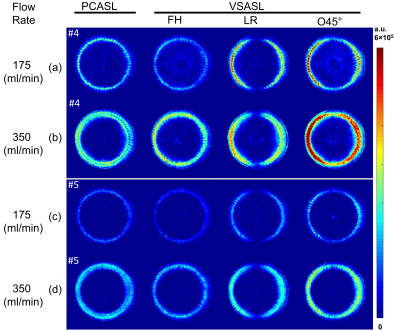Feng Xu1,2, Dan Zhu3, Hongli Fan2,3, Hanzhang Lu1,2, Dapeng Liu1,2, Wenbo Li1,2, and Qin Qin1,2
11The Russell H. Morgan Department of Radiology and Radiological Science, Johns Hopkins University, Baltimore, MD, United States, 2F.M. Kirby Research Center for Functional Brain Imaging, Kennedy Krieger Institute, Baltimore, MD, United States, 3Biomedical Engineering, Johns Hopkins University, Baltimore, MD, United States
11The Russell H. Morgan Department of Radiology and Radiological Science, Johns Hopkins University, Baltimore, MD, United States, 2F.M. Kirby Research Center for Functional Brain Imaging, Kennedy Krieger Institute, Baltimore, MD, United States, 3Biomedical Engineering, Johns Hopkins University, Baltimore, MD, United States
Velocity-selective inversion (VSI)
prepared arterial spin labeling was examined using a commercial perfusion phantom. Careful selection of
velocity-encoding directions along the major feeding arteries is recommended
for VSASL applications to attain optimal labeling efficiency.

Figure 3. ASL difference images of the slice #4 (a-b)
and #5 (c-d) at flow rates of 175 (a) and 350 (b) mL/min. The slice
#4 is at the second layers of porous material with 60 channels extended axially
(off-center) in a circle. These 60 channels stop prior to slice #5. PCASL (1st
column), VSASL using encoding directions of foot-head (FH, 2nd column),
left-right (LR, 3rd direction) and oblique 45° (O45°, 4th column).

Figure
4. Ring ROIs and their normalized difference of slice #5 as a function of
angular locations at flow rates of (a) 175 and (b) 350 mL/min, respectively.
Normalized difference signal was averaged along the radius direction at every
0.5° from 0° to 360°. Half circle signal ranging from 45° to 225° was displayed
for PCASL, VSASL with encoding directions of FH, LR and O45°. Green and yellow bars
on the ring ROIs, corresponding to the green and yellow shades centered around 180°
and 90° angles in VSASL (LR), indicate left and top sectors selected for
labeling efficiency estimation in Figure 5.
